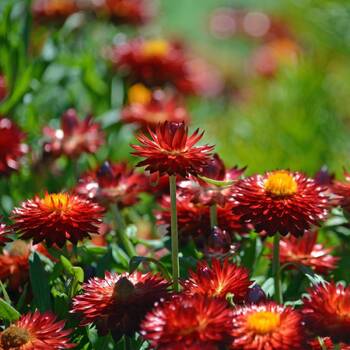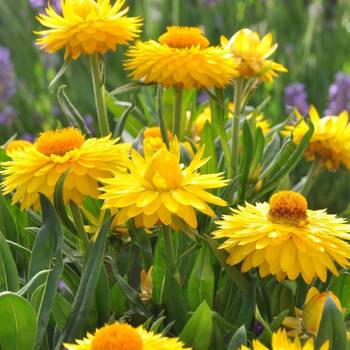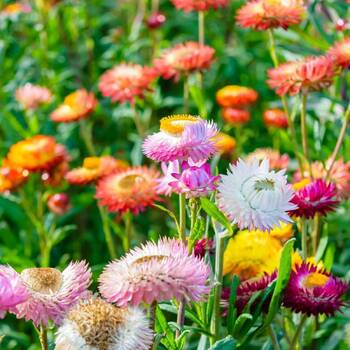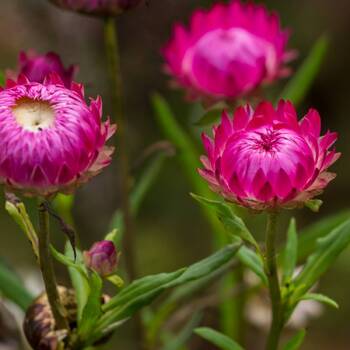
How to Grow Everlasting Daisy Seeds
Grow Guide #2269
Family: Asteraceae
Binomial name: Xerochrysum bracteatum
Life Cycle: Short-lived Perennial
This 'How to Grow' guide details everything a home gardener needs to know to plant, grow and care for Everlasting daisies (Xerochrysum bracteatum).
Everlasting daisies (Xerochrysum bracteatum), paper daisies (Rhodanthe sp.) and showy everlastings (Schoenia filifolia) are all wildflowers commonly called paper or everlasting daisies. All three are grown in a similar way, but paper daisies and showy everlastings are annuals while everlasting daisies are perennials. Learn how to grow paper daisies and showy everlastings here.
When to Sow Everlasting daisy Seeds
Everlasting daisies can be grown year-round in most climates. Avoid planting in extremely hot or cold weather which can affect germination and growth. Use the table below to identify the best time of year to sow everlasting daisies in your climate.
| JAN | FEB | MAR | APR | MAY | JUN | JUL | AUG | SEP | OCT | NOV | DEC | |
|---|---|---|---|---|---|---|---|---|---|---|---|---|
| Cool | ||||||||||||
| Temperate | ||||||||||||
| Sub-Tropical | ||||||||||||
| Tropical | ||||||||||||
| Arid |
Preparation
Everlasting daisy plants are perennial, meaning they live for several years. Choose a permanent position where plants can grow undisturbed by regular digging.
Everlasting daisy plants are best grown in full sun. Choose a location that will receive at least 6 hours of full sun each day.
Everlasting daisy plants need a very well drained soil. In most cases there is no need to enrich soil with manure or other fertilisers. Prepare soil by weeding it thoroughly and digging it over to loosen it. Keep the area free of weeds until planting. Learn more about preparing soil for planting here.
Everlasting daisy plants can be grown in containers. If possible choose a variety that’s recommended for container growing. Use a good quality potting mix and make sure your container is large enough for mature plants; a minimum of 20 litres is recommended for everlasting daisies. During the growing season, keep in mind that container grown plants may need additional fertiliser to encourage healthy growth.
How to Sow Everlasting daisy Seeds
Everlasting daisy seeds do not require any treatment (eg soaking, stratification) before sowing.
Exposure to light may help improve germination rates; sow seeds at the recommended depth, pressing the seeds onto damp soil and very lightly covering them with fine soil.
Everlasting daisy seeds can be sown directly into the garden OR seedlings can be raised in trays or other containers and transplanted to the garden once established.
Sow Direct
- Sow seeds directly in the garden 1mm deep and 40-60cm apart.
- Keep soil moist but never wet or dry.
- Seeds should germinate in around 7-14 days at a soil temperature of 18-21°C.
- Young seedlings will need protection from pests, pets and weather until they are established.
Raise Seedlings
- Fill trays, punnets or jiffy pots with a good quality seed-raising mix, or use soil starter pellets.
- Sow seeds 1mm deep.
- Keep soil moist but never wet or dry.
- Seeds should germinate in around 7-14 days at a soil temperature of 18-21°C.
- Transplant seedlings to the garden once they have their first true leaves and are large enough to handle (usually 5-10cm tall).
- Plant out, spacing plants 40-60cm apart.
Tip: Everlasting daisy seeds can also be sown in the less formal ‘scatter seed’ method. Simply roughen the soil, scatter seeds evenly over the surface, then smooth the soil over lightly to cover the seeds.
How to Grow Everlasting daisy
Everlasting daisy plants are drought tolerant once established and grow best in soil that is dry and very well drained. Let the soil dry out between watering, and only water when the soil is dry about 10cm below the surface (test this by scratching away a little soil with your finger), even in summer. Water deeply in the early morning or late afternoon. Avoid watering the leaves of plants to avoid fungal diseases. Learn more about watering here.
Everlasting daisy plants will grow in nutrient-poor soils and do not need additional fertiliser during the growing season.
Everlasting daisy plants should flower in approximately 80-90 days.
If growing everlasting daisies for cut flowers, use sharp snips or secateurs to cut the longest stems possible, removing the lower leaves and placing the stems immediately in a clean bucket of water. Learn more about cutting and conditioning homegrown flowers here.
Deadhead everlasting daisy flowers regularly during the growing season. Using sharp secateurs or snips cut fading or dead flowers off just above a set of leaves. Removing old flowers regularly will encourage plants to produce more flowers. Learn more about deadheading flowering plants here.
When plants have finished flowering prune them back to neaten them and encourage strong new growth. Using sharp secateurs or snips, cut individual stems just above a set of lower leaves.
Common Problems when Growing Everlasting daisies
Like all plants, everlasting daisy is susceptible to some pests, diseases and other problems. Below is a list of the most common problems gardeners encounter when growing everlasting daisy plants:
 Aphids are small (2-4mm long) sap-sucking insects that congregate on the new shoots or the undersides of leaves. They can cause leaves to wilt or become discoloured, and also excrete honeydew which can attract ants and other insect pests. To manage aphids, remove them by spraying with a garden hose, apply a soap or alcohol spray, or encourage predatory insects to your garden. Read more about aphids here.
Aphids are small (2-4mm long) sap-sucking insects that congregate on the new shoots or the undersides of leaves. They can cause leaves to wilt or become discoloured, and also excrete honeydew which can attract ants and other insect pests. To manage aphids, remove them by spraying with a garden hose, apply a soap or alcohol spray, or encourage predatory insects to your garden. Read more about aphids here..jpg) Powdery mildew is caused by fungal spores reproducing on the leaves of plants. First showing as white spots on leaves, affected areas can spread quickly to cover the entire leaf surface. While rarely fatal, powdery mildew can reduce yields. Water plants at soil level (not on leaves) to prevent spreading spores, allow good air flow between plants, remove affected leaves and if necessary spray with an appropriate fungicide or homemade spray. Read more here about powdery mildew here.
Powdery mildew is caused by fungal spores reproducing on the leaves of plants. First showing as white spots on leaves, affected areas can spread quickly to cover the entire leaf surface. While rarely fatal, powdery mildew can reduce yields. Water plants at soil level (not on leaves) to prevent spreading spores, allow good air flow between plants, remove affected leaves and if necessary spray with an appropriate fungicide or homemade spray. Read more here about powdery mildew here. Slugs and snails are molluscs that feed on tender leaves and shoots, mostly at night, leaving slimy trails behind them. Control them by removing their hiding places, keeping free range poultry, collecting them by torchlight or by placing traps. Read more about slugs and snails here.
Slugs and snails are molluscs that feed on tender leaves and shoots, mostly at night, leaving slimy trails behind them. Control them by removing their hiding places, keeping free range poultry, collecting them by torchlight or by placing traps. Read more about slugs and snails here.


.png)






